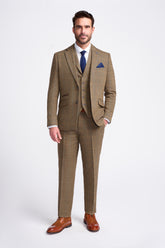Buying a suit can be… an experience. Even for the initiated, the choices in fit, fabric, combinations and colours are enough to bring on a bout of purchasing panic. In our book, suit-buying should be a thoroughly enjoyable affair. In this informative guide, you’ll pick up a few pointers for comfortably navigating the vast sea that is buying a suit.
Colour
Good-looking suits come in a variety of different colours. A navy suit, however, is one of the most versatile suits you can opt for. It pairs beautifully with several colours, is appropriate for numerous occasions across the seasons and also performs well as a broken suit. Navy suits can also support patterned fabrics without appearing too unorthodox – if pared-back is what the situation calls for! A navy suit with a light check is an understated but stylish upgrade to a bloc colourway. Similarly, a navy suit in a coarser texture might be a smart decision for an autumn event.

What is the best suit material?
This can be a difficult one to get right. There are multiple fabrics that suits can come in. from cool linen to more textured wool fabrics. Suits made from a wool and synthetic blend will keep those glossy synthetics at bay. These are the kinds of suits that are versatile and flexible.
100% wool suits will give you a wonderfully refined look, especially in navy. They can, however, be harder to keep clean because wool tends to attract dust and lint. Make sure if you choose wool, it is kept well-brushed and neat.
Tweed Suits
A lovely alternative that you can opt for is a tweed suit. Tweed has the refinement that wool suits give you with the natural texture and pattern that you get from a checked design. A tweed suit shouldn’t evoke farming because it can also provide a remarkable balance between classic and contemporary. This is particularly true for blue tweed suits when paired with bold accents – such as the perfect tie and pocket square combination.

What about slim fit suits?
Whether or not you choose a slim fit suit or not depends on your build. A slim fit suit is flattering on slimmer men because looser fits can look baggy. If you are short, a slim suit will elongate your frame, whereas a regular fit may compress your physique. If you’re a broader man, keep the fit of your suit regular or tailored for a fitted but not restricted silhouette. For taller men, you might not need your features elongating.

Beyond this, here are five straightforward do’s and don’ts when it comes to sizing a suit to consider:
- The length of the jacket shouldn’t go past your fingertips or be higher than the wrist.
- Shirt sleeves should be just about visible beyond the jacket sleeves.
- If your suit pinches when buttoned, it is too small. If it appears to slouch or sag, it is too big.
- Shoulder panels should not extend past your shoulders.
- Never have the bottom button fastened (this usually applies for anything you happen to button up!).
How to measure for a suit
When wondering how to measure for a suit, there are few substitutes for a tailor. Failing that, grab a tape measure and take down these measurements
How to measure suit trousers
Firstly, and crucially, wear a pair of trousers which you already like the fit of.
- Waist and hips (this is where your trousers sit and then the slightly wider bit).
- Thigh and knee. For your thigh, this is right at the top of the trouser.
- Crotch (or rise). Measure from the front of your belt line under the rise of the trousers to the back of your belt line.
- Inner and outer leg. The inner leg is from the bottom of the rise to the bottom of the leg.
How to measure for a Suit Jacket
- Chest and overarm. Put the tape measure around your chest under your arms. Do the same but for around the top of your arms.
- Neck. Measure where your collar would sit.
- Shoulders. This is on your back, and from the tip of each shoulder. Make sure it follows the natural curve of your body.
- Wrist and bicep circumference.
- Sleeve length with your arm relaxed by your side.
- Stomach (around about the belly button area).
- The jacket length. This measurement should be from your collar to about the base of the thumb.
Suit trousers – mix or match?
As a rule of thumb, your suit trousers look best when they’re just sitting on the top of your shoe. This is especially the case for suits that are tailored or not on the slim side. For slim suits, there is a little more room to show some ankle – or a pop of colour if you’ve opted for an eye-catching pair of socks. For less formal occasions try a broken suit, which means trading out either the jacket or trousers. For this, a pair of well-fitted jeans will work for optimum relaxed business casual, or for the perfect transitional look, some lighter chinos.
How to clean a suit
Taking care of your suit once it is your is crucial in keeping it looking great wear after wear. Avoiding mess can be a hard task, especially when wearing a suit sometimes means you’re meant to be enjoying yourself! This five-point checklist will help you look after your suit:
- Use a damp, non-abrasive cloth to blot out accidental blemishes.
- Invest in a suit carrier if you haven’t already.
- Hang your suit up as soon as you take it off on quality hangers
- Steam your suit. This gives your suit a regular freshening up.
- Use a soft clothes brush.
With this handy guide, you are hopefully well-equipped with everything you need to know about buying a suit. Now comes the fun bit with accenting, mixing up and even dressing your suit down with a pair of crisp kicks.












